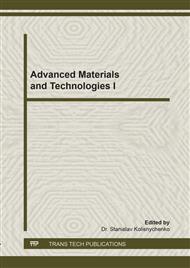[1]
J. Harold F. Reetz, Fertilizers and their efficient use, World Fertil. Use Man., (2016).
Google Scholar
[2]
P. Heffer and M. Prud, Fertilizer Outlook 2016-2020, 84rd IFA Annu. Conf., no. June, (2016).
Google Scholar
[3]
FAO, World fertilizer trends and outlook to 2018, Food Agric. Organ. United Nations, (2015).
Google Scholar
[4]
M. E. Trenkel, Slow- and Controlled-Release and Stabilized Fertilizers: An Option for Enhancing Nutrient Use Efficiency in Agriculture, Paris, (2010).
Google Scholar
[5]
A. Shaviv, Controlled release fertilizers, Frankfurt, (2005).
Google Scholar
[6]
Y. P. Timilsena, R. Adhikari, P. Casey, T. Muster, H. Gill, and B. Adhikari, Enhanced efficiency fertilisers: A review of formulation and nutrient release patterns, J. Sci. Food Agric. 95 (2015) 1131-1142.
DOI: 10.1002/jsfa.6812
Google Scholar
[7]
C. Feng et al., Smart Fertilizer with Temperature- and pH-Responsive Behavior via Surface-Initiated Polymerization for Controlled Release of Nutrients, ACS Sustain. Chem. Eng. 3 (2015) 3157–3166.
DOI: 10.1021/acssuschemeng.5b01384
Google Scholar
[8]
Z. Majeed, N. K. Ramli, N. Mansor, and Z. Man, A comprehensive review on biodegradable polymers and their blends used in controlled-release fertilizer processes, Rev. Chem. Eng. 31 (2015) 69–95.
DOI: 10.1515/revce-2014-0021
Google Scholar
[9]
B. Azeem, K. Kushaari, Z. B. Man, A. Basit, and T. H. Thanh, Review on materials & methods to produce controlled release coated urea fertilizer, J. Control. Release. 181 (2014) 11-21.
DOI: 10.1016/j.jconrel.2014.02.020
Google Scholar
[10]
J. Chen et al., Environmentally friendly fertilizers: A review of materials used and their effects on the environment, Sci. Total Environ., 613 (2018) 829–839.
Google Scholar
[11]
F. H. Otey, D. Trimnell, R. P. Westhoff, and B. S. Shasha, Starch Matrix for Controlled Release of Urea Fertilizer Felix, J. Agric. Food Chem. 32 (1984) 1095–1098.
DOI: 10.1021/jf00125a041
Google Scholar
[12]
A. Sarwono et al., Swelling mechanism of urea cross-linked starch–lignin films in water, Environ. Technol. 0 (2017) 1–11.
Google Scholar
[13]
S. A. Riyajan, Y. Sasithornsonti, and P. Phinyocheep, Green natural rubber-g-modified starch for controlling urea release, Carbohydr. Polym. 89 (2012) 251–258.
DOI: 10.1016/j.carbpol.2012.03.004
Google Scholar
[14]
L. Chen, Z. Xie, X. Zhuang, X. Chen, and X. Jing, Controlled release of urea encapsulated by starch-g-poly(l-lactide), Carbohydr. Polym. 72 (2008) 342–348.
DOI: 10.1016/j.carbpol.2007.09.003
Google Scholar
[15]
X. Han, S. Chen, and X. Hu, Controlled-release fertilizer encapsulated by starch/polyvinyl alcohol coating, Desalination. 240 (2009) 21–26.
DOI: 10.1016/j.desal.2008.01.047
Google Scholar
[16]
G. Ceriotti and L. Spandrio, A spectrophotometric method for determination of urea, Clin. Chim. Acta. 8 (1963) 295–299.
DOI: 10.1016/0009-8981(63)90171-2
Google Scholar
[17]
I. Hussain, Z. Mahmood, R. Yasmeen, M. Jahangir, R. Hammed, and R. Nasir, Assay of urea with p-dimethylaminobenzaldehyde, Journal-Chemical Society of Pakistan. 24 (2002) 122–128.
Google Scholar


